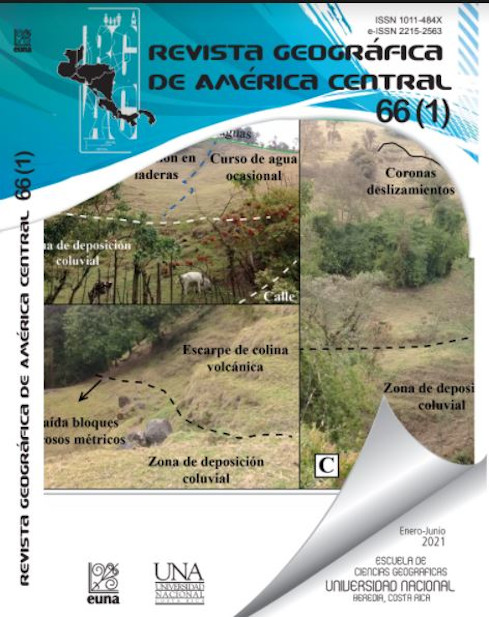Aeolian deposits of the humid tropics: case of the marine-coastal strip of the eastern part of the Azuero Peninsula, Panama.
DOI:
https://doi.org/10.15359/rgac.66-1.4Keywords:
Wind erosion, Sand clasts, Aeolian deposits, Tropical climateAbstract
The purpose of the investigation was to demonstrate the incidence of wind as a morphogenetic agent through the correlation of the sand clasts that constitute the marine-coastal geofacies. Morphoclimatic limit theory was selected and the data on temperature, precipitation and winds compiled; field activities included the classification of the geoforms of accumulation and erosion as well as the sampling of sands per geofacies. Sand samples (453 g) were sieved to separate their components and assay clast sizes, followed by stereomicroscopic examination to determine roundness and sphericity by visual comparison. Subsequently, the sample from the coastal plain (1 g) was treated with 1N potassium dichromate solution (K2Cr2O7) and sulfuric acid (H2SO4), to oxidize and eliminate organic matter and determine its genesis. Finally, the correlation between mesolittoral sand as independent variable and origin of aeolian deposits per geofacies was found to be of positive linear nature with high correlation coefficients (ρ) for coastal dunes (ρ ± 0.98), nebka dunes (ρ ± 0.98) and sand mantles (ρ ± 0.96).
References
Ayoade, J. (2011). Introdução à climatologia para os trópicos. (15ª ed). Rio de Janeiro, Brasil: Editora Bertrand LTDA.
Bernat, M. y Pérez, A. (2005). Campos de dunas y mantos e ólicos de Tierra de Pinares: Sureste de la cuenca del Duero. España. Boletín Geológico y Minero, 116 (1), pp. 23-38. Recuperado de: https://www.researchgate.net/publication/259226985_Campos_de_dunas_y_mantos_eolicos_de_Tierra_de_Pinares_Sureste_de_la_cuenca_del_Duero_Espana
Bertrand, G. y Bertrand, C. (2007). Uma Geografía transversal e de travessias: O meio ambiente através dos territórios e das temporalidades. Brasil: Editora Massoni.
Blyth, F. y de Freitas, M. (1989). Geología para ingenieros. México: Compañía editorial continental, S.A.
Carreira, D. (2011). Cuantificación de la Materia Orgánica del suelo. Método de Walkley & Black. Trabajo presentado en la Jornada de Actualización: Gestión de la calidad en los laboratorios de análisis de suelos agropecuarios. SAMLA- PROINSA. Rosario, Argentina. Recuperado de: https://inta.gob.ar/sites/default/files/script-tmp-anlisis_de_c_y_n.pdf
Díaz, R. (2011). Desarrollo sustentable: Una oportunidad para la vida. (2ª ed). México D.F: Editora McGraw-Hill.
Eyherabide, M., Saínz, H., Barbieri, P. y Echeverría, H. (2014). Comparación de métodos para determinar carbono orgánico en suelo. Ciencia del Suelo (Argentina) 32 (1), pp. 13-19. Recuperado de: https://www.researchgate.net/publication/276917420_COMPARACION_DE_METODOS_PARA_DETERMINAR_CARBONO_ORGANICO_EN_SUELO
Graig, J. R., Vaughan, D.J. y Skinner, B.J. (2012). Recursos de la Tierra y el medio ambiente. (4ª ed). Madrid, España: Pearson Educación, S.A.
Gutiérrez, M. (2009). Geomorfología. Madrid, España: Pearson Educación.
Instituto Geográfico Nacional “Tommy Guardia”. (2016). Atlas Nacional de la República de Panamá. (5ª ed). Colombia: Impresiones Carpal.
Kenitiro, S. (1973). Introdução à sedimentolologia. São Paulo, Brasil: Editora Edgard Blucher Ltda.
Mateo, J. (2012). La dimensión espacial del desarrollo sostenible: Una visión desde América Latina. La Habana, Cuba: Editorial UH.
Ministerio de Vivienda y Ordenamiento Territorial. (2006). Ley 6; por la cual se reglamenta el Ordenamiento Territorial para el desarrollo urbano y se dicta otras disposiciones. Recuperado de: https://docs.panama.justia.com/federales/leyes/6-de-2006-feb-3-2006.pdf
Ministerio de Vivienda y Ordenamiento Territorial. (2009). Resolución No 4; por la cual se establece el procedimiento y los requisitos para la tramitación de solicitudes relacionadas con el ordenamiento territorial para el desarrollo urbano. Recuperado de: https://www.gacetaoficial.gob.pa/pdfTemp/26221/16057.pdf
Patton, C., Alexander, C. y Kramer, F. (1983). Curso de Geografía Física. España: Ediciones Vicens-Vives.
Peel, M.C., Finlayson, B.L. y McMahon, T.A. (2007). Updated world map of the Köppen-Geiger climate classification. Recuperado de: https://www.hydrol-earth-syst-sci.net/11/1633/2007/hess-11-1633-2007.pdf
Pérez, A. y Márquez, A. (2017). Sedimentología. Universidad Autónoma Metropolitana, Unidad Iztapalapa (División de Ciencias Biológicas y de la Salud). México. Impreso México D.F.
Rivera, J. (2016). Avaliação geoecológica aplicada à ordenação ambiental da paisagem marinho-costeira: caso da bacia hidrográfica do Rio Purio Província dos Santos – Panamá (Tesis doctoral). Instituto de Geociências e Ciências Exatas, Departamento de Geografia, Universidade Estadual Paulista. Brasil. (p.198).
Robinson, E. (1990). Geología física básica. México: Editorial limusa, S.A.
Sánchez, J. (2003). Geomorfologia: Ambiente e Planejamento. (7ª ed.). São Paulo, Brasil: Editora Contexto.
Schober, P. Boer, C y Schwarte, L. (2018). Correlation coefficients: Appropriate use and interpretation. Journal Anesthesia & Analgesia (United States of America), 126 (5), pp. 1763-1768. Recuperado de: https://journals.lww.com/anesthesia-analgesia/fulltext/2018/05000/correlation_coefficients__appropriate_use_and.50.aspx
Tarbuck, E. y Lutgens, F. (2013). Ciencias de La Tierra. Una Introducción a la Geología Física. (10ª ed). Madrid, España: Pearson Educación.
Teixeira, A. y Dos Santos, M. (2015). Geomorfología Ambiental. (7ª ed). Rio de Janeiro, Brasil: Bertrand Brasil.
Troppmair, H. (2012). Biogeografia e meio ambiente. (9ª ed). Rio de Janeiro, Brasil: Technical books editora.
Verstapen, H.T. y Zuidam, R.A. (1975). ITC System of geomorphological survey. Netherlands: Manuel ITC Textbook. Vol. VII, Chapter VII.3.
Wicander, R. y Monroe, J. (2009). Fundamentos de Geología. São Paulo, Brasil: Cengage Learning Edições Ltda.
Downloads
Published
How to Cite
Issue
Section
License
Proposed policy for journals offering Open Access
Authors publishing their works in the Journal acknowledge and agree to the following terms:
a) Authors retain the copyrights to their works and guarantee the Journal the right to be the first to publish their works, under the Creative Commons License Attribution-NonCommercial-ShareAlike 4.0 International, CC BY-NC-SA 4.0 International (https://creativecommons.org/licenses/by-nc-sa/4.0/deed.es), which allows others to share works upon complying with the acknowledgment of authorship and mention of the Journal as the original publisher of the work.
b) Authors are permitted to separately establish additional agreements for the non-exclusive distribution of the official edition of the work published in the Journal (for example, authors may desire to place the work in an institutional repository or incorporate it into a book that is to published elsewhere) so long they acknowledgment to recognize the Journal as the original publisher. The aforementioned additional agreements must respect the terms of the non-profit character and sharing philosophy of the original license (CC BY-NC-SA 4.0 International, https://creativecommons.org/licenses/by-nc-sa/4.0/deed.es).
c) Authors are encouraged to archive the post-print or editor/PDF version in Open Access repositories.






 REVGEO is licensed under https://creativecommons.org/licenses/by-nc-sa/4.0/deed.es
REVGEO is licensed under https://creativecommons.org/licenses/by-nc-sa/4.0/deed.es
.svg_4.png)

_(1).png)
_(1)_(1)_(1)_1.png)
(2)(1)(1)(1).png)
